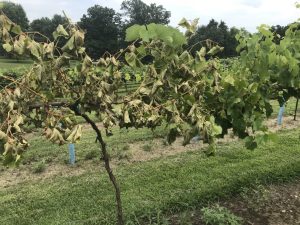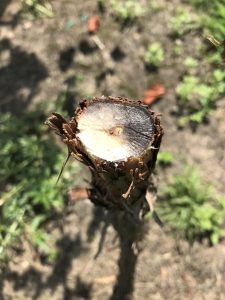Published on
Updated on
Contents:
- Apoplexy
- Announcement: Grape and Equipment Exchanges
- Cumulative Growing Degree Days (Base 50) for the Seven Grape Growing Regions of Missouri from April 1 to Aug. 22, 2020
- Weather Outlook
Apoplexy

Viticulturalists are often called to grower’s vineyards to diagnose a problem that is causing vine decline and even plant death. One of the most alarming declines of a grapevine that a grower may observe is apoplexy (Figure 1), where one day the vine appears perfectly healthy and the next day the vine is completely wilted. Apoplexy often shows up when there has been a period of drought. Drought, however is not the causal agent of apoplexy; drought simply is an environmental component that exacerbates the onset of apoplexy. The causal agent apoplexy is out of sight or hidden within the grapevine. Only through destructive dissection of the grapevine will the causal agent be revealed (Figure 2).
Before revealing the causal agent(s) of apoplexy, I would first like to explain the importance of vine dissection. A quick diagnosis of a vine displaying apoplexy would be to simply state the vine has a trunk disease and the solution is to remove the vine from the vineyard. However, there is the potential to rescue a vine and retrain a root-sucker up from own rooted grapevines or retrain a new shoot up from a grafted vine. The first thing that has to be done is determine how far the disease has progressed in the grapevine. First, starting at one of the cordons, start cutting 2-inch cross-sections with a lopper. Look at the cross-sections and look for discoloration within the cross-sections. Keep cutting cross-sections until you find healthy wood. If the wood is stained and looks unhealthy once you are to the head of the vine, then repeat the process with the other cordon. Next, start cutting cross-sections down the trunk, starting at the head of the grapevine. Your objective is to determine where in the trunk the disease has advanced. If the discoloration has advanced to the crown of the plant of an own-rooted grapevine, this would suggest the disease has also traveled to the roots, and the vine should be removed. However, if the discoloration has not advanced to the crown, the trunk can be removed below the discoloration, and a new sucker can be retrained to replace the diseased grapevine. The timing of making these cuts is important since you want to reduce the potential for reinfection.
Most trunk disease pathogens release infective spores during cool moist periods. Often these spore releases coincide with the timing of dormant pruning in the early winter and early spring. Although there is currently no data available for when trunk diseases are releasing spores in Missouri, the biology and ecology of the fungal organisms causing trunk diseases suggest that the time of spore release is coincides with cool wet weather conditions in late winter to early spring. Hopefully, future research in Missouri will provide data on the window of spore release for some of the most detrimental trunk diseases.
Large pruning cuts, such as removing a cordon or removing a trunk should be done during dry weather and warm temperatures. In Missouri, these environmental conditions would coincide with the months of June through August. During these months there is a reduced risk of infective trunk disease spores causing an infection. Delaying the diagnosis of a vine displaying apoplexy this season until the upcoming dormant pruning or even the following summer period (June-August) can be detrimental. The disease will have an extended time period to progress in the vine, potentially precluding the opportunity to raise up a new sucker to replace the diseased vine. Also, the diseased vine likely will release infective spores during the late winter to early spring dormant pruning period. Delaying diagnosis and or vine removal may subject healthy vines in the vineyard to infective trunk disease spores.
Causal Agent(s) of Apoplexy
Apoplexy is caused by Esca, which is a complex of fungi that includes several species of Phaeocremonium and Phaeomoniella chlamydospore. In mature grapevines Esca is often attributed to Phaeocremonium aleophilium. Commonly P. aleophilium is also found with Phaeomoniella chlamydospora in grapevines displaying ESCA symptomology. Last June, the Flying Vine Doctor, Richard Smart and I did a small survey of grapevines displaying trunk disease symptoms in Missouri vineyards (To learn more and view cross-sections of grapevine trunks infected with Phaeocremonium spp. and Phaeomoniella spp.) In addition, wild grapevines were also evaluated. In both symptomatic grapevines from vineyards and wild grapevines the most common taxa was Phaeocremonium spp. and Phaeomoniella spp. Both of these fungi have been found in young vines that are in decline. In this case, Lucie Morton coined the terminology “Black goo” to describe what she observed in young (3-year-old grapevines) that were declining and dying.
Management

Trunk diseases can be spread in propagation material. Similar to grapevine viruses, fungal species that cause trunk diseases are not visible to the naked eye in cane-wood used for propagation. Nurseries that propagate grapevines are taking steps to reduce trunk disease fungal organisms. Hot water treatments of 50°C for 45 to 60 minutes are being used. Additionally, some nurseries have employed protocol 2010, which begins with planting virus free stock that originated from Foundation Plant Service. The nurseries then continue testing these field planted vines on a yearly schedule. Vines that test positive for a specific organism are removed. Many of the trunk disease fungi are not host specific to grapes and can infect other woody plants. Many of these fungi are endophytes, meaning the fungi live within the host plant. The endophytes often will become a problem and begin the disease process when the grapevine has become stressed. Common stresses that start endophytic fungi in motion that result in disease are drought and saturated soils. In Missouri, drought stresses have occurred in nine of the last 10 years in some locations within the state.
Sanitation
All woody vine material that can be removed from a vineyard should be buried or burned. The trunk disease fungi can live and release spores from woody material that has been placed in piles nearby a vineyard. Wind gusts during rainy periods can transmit these spores to the vineyard. Entry into the grapevine is often through pruning wounds. Once the spore germinates and enters into the grapevine, there is no way to chemically control the organism. Although, next spring I will be evaluating a new fungicide that has systemic properties that has shown promise in controlling some trunk diseases in California trials.
Other Common Trunk Diseases in Missouri
A recent survey of grape cultivars established at the Horticulture and Agroforestry Research Center in New Franklin, MO determined that Phomopsis viticola was the most prevalent trunk disease. Research published in 2012 by José Ramón Úrbez-Torres of vines exhibiting trunk disease symptoms identified Botryosphaeria canker, Eutypa die-back and esca in Missouri vineyards. In total José identified 15 fungal taxa including Phomopsis viticola. There have been 133 species identified representing 24 genera that cause trunk diseases in grapevines. Economically important trunk diseases are Botryosphaeria canker, Eutypa dieback and esca and P. viticola. There likely are other economically important trunk diseases in Missouri including Pestolotiopsis spp.
In summary, if you observe a vine with apoplexy, you should dissect the vine to deter-mine how far the disease has advanced within the grapevine. If clean wood is found below the advancing fungal growth in the trunk, cut the vine off at the soil level. Start training a new root sucker to replace the vine. I highly suggest always bringing a root sucker up from the ground, instead of bringing a shoot up from a trunk stub. Realize that some grape cultivars produce root suckers profusely whereas some grape cultivars produce almost no root suckers. Remember, if you have grafted grapevines that you retrain a shoot from the scion. When sourcing new vines for planting ask your nursery what protocols are in place to reduce the potential of trunk diseases. Lastly, get woody pruning waste out of the vineyard and be sure to burn or bury the material.
Announcement: Grape and Equipment Exchanges
The Grape Exchange on the Grape and Wine Institute’s web page is posting listings.
Please submit your listing to Karissa King at kingkari@missouri.edu. Please submit the following information: varietal, tons, and contact information.
The Grape and Wine Institute is also initiating an Equipment Exchange that includes equipment in the vineyard and winery. These items can also be submitted to Karissa King as above. Please submit the following information: equipment type, any necessary description, and contact information.
Cumulative Growing Degree Days (Base 50) for the Seven Grape Growing Regions of Missouri from April 1 to Aug. 22, 2020
| Region | Location by County | Growing Degree Days1 | ||
|---|---|---|---|---|
| 2020 | 2019 | 30-year Average | ||
| Augusta | St. Charles | 2679 | 2817 | 2761 |
| Hermann | Gasconade | 2561 | 2745 | 2667 |
| Ozark Highland | Phelps | 2766 | 2925 | 2875 |
| Ozark Mountain | Lawrence | 2740 | 2869 | 2808 |
| Southeast | Ste. Genevieve | 2718 | 2866 | 2843 |
| Central | Boone | 2729 | 2848 | 2736 |
| Western | Ray | 2603 | 2665 | 2673 |
1 Growing degree days at base 50 from April 1 to Aug. 22, 2020. Data compiled from Useful and Useable at U2U Decision Support Tools – Corn GDD. Click on link below to determine growing degree days in your area.
To determine the number of growing degree days accumulated in your area since April 1, use this tool.
Weather Outlook
Weather Outlook for Weekend
- Central Missouri could receive 0.25 inches of precipitation from hurricane Laura
- Most of Missouri could receive 0.25 to 0.5 inches of precipitation starting on Saturday through Monday
Aug. 31 to Sept. 4
- Below normal temperatures
- Above normal chance of precipitation. Starting on Monday and through Wednesday, most of Missouri could receive precipitation, ranging from 2 to 3 inches